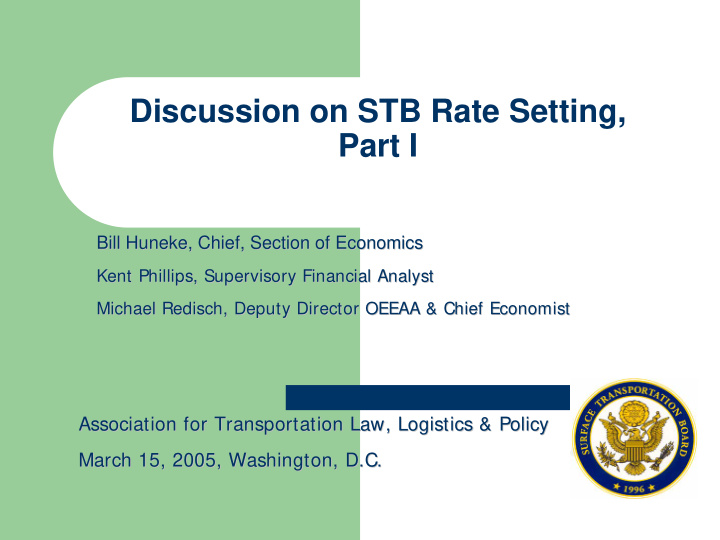



Discussion on STB Rate Setting, Part I Bill Huneke, Chief, Section of Economics Bill Huneke, Chief, Section of Economics Kent Phillips, Supervisory Financial Analyst Kent Phillips, Supervisory Financial Analyst Michael Redisch, Deputy Director OEEAA & Chief Economist Michael Redisch, Deputy Director OEEAA & Chief Economist Association for Transportation Law, Logistics & Policy Association for Transportation Law, Logistics & Policy March 15, 2005, Washington, D.C. March 15, 2005, Washington, D.C.
Disclaimers � Board speaks through its decisions � Opinions expressed here are the views of the individual, not the Board
Ground Rules � We cannot discuss cases or issues currently before the Board � We will take questions as they come up
Major Topics � Public Policy Goals � Economic Framework � Components of a SAC Case � Evaluation of Evidence � Concluding Thoughts
Public Policy Goals � Overview of what Congress has tasked
Private Sector Initiatives Railroad Transportation Policy Public Regulation Interest
Rely on Competition Private Sector Initiatives Individual Revenue Pricing Adequate Railroads
Needs of Public/National Defense Honest, Fair Wages/ Efficient Safe Working Management Conditions Public Interest Intermodal Energy Competition/ Conservation Coordination Public Health/Safety
Minimize Regulatory Control Expeditious Reasonable Complaint Rates Resolution Regulation Reduce Accurate Regulatory Costing Entry/Exit Information Barriers Prohibit Predatory Pricing
The Public Policy Balance � 49 USC Section 10101(6): "To maintain reasonable rates where there is an absence of effective competition and where rail rates provide revenues which exceed the amount necessary to maintain the rail system and to attract capital."
Balancing Competing Needs � Limited jurisdiction. � Contract movements � Revenue to Variable Costs < 180% � Competitive movements � Rate Guidelines � Ex Parte 347 (Subs 1 & 2) � Economic theories – Baumol et al.
Economic Framework � "A captive shipper should not bear the costs of any facilities or services from which it derives no benefit." – Demand-Based Differential Pricing � Mimics Ramsey Pricing – The STB’s Contestable Market Theory via Baumol et al.
Application of Theory � The Coal Rate Guidelines establish four pricing constraints – Revenue Adequacy – Management Efficiency – SAC – Phasing
SAC Constraint � Purpose of SAC � Fits with economic theory � Grouping � "We have not attempted to prescribe a hard and fast formula for developing and applying SAC. Rather, we encourage the parties in individual proceedings to develop the evidence which best presents their case."
Components of Stand-Alone Cases � Configuration � Traffic Group � Operating Plan � Operating Expenses � Engineering � Discounted Cash Flow Model
SAC Configuration � Stand-Alone Railroad (SARR) must serve complainant – origin-destination – all of the issue traffic � Not required to replicate existing operations
SAC Traffic Group 1 � Wide latitude for choosing traffic group – Defend selection for traffic group – Rerouting traffic – Cross-subsidy concerns
SAC Traffic Group 2 � Use of forecasts – Use of forecasts agreed to by the parties – Out-year forecasts (EIA) – Use of same forecasts for both volumes and revenues
SAC Traffic Group 3 � Cross-over traffic and revenue allocation – Remains controversial � Reverse cross-subsidy � Proper allocation of revenues – Remains acceptable � Acceptable modeling device
SAC Operating Plan � SARR may operate however it deems most efficient � SARR must defends it Operating Plan assumptions � Operating Expense stem from Operating Plan assumptions
SAC Operating Plan - Improvement � Factors to review at SAC Tech. Conference � Similar to VC Tech. Conference – 22 factors, e.g. mileage, tare weight, etc. � For SAC Operating Plan – Similar number of factors – For example, number of trains, number of cars, cycle time components, etc.
SAC Engineering � Engineering is derived from the Configuration and Operating Plan � Generally not too controversial � Areas to watch: real estate and maintenance of way expenses
SAC DCF Model � Confluence of a SAC analysis � Flows revenues and expenses of SAC analysis period � Compares revenues and expenses of the SARR over the SAC analysis period
CoC, Taxes, IDC, and System Other factors Configuration Road Property Investment Shipper Selected Vetting Traffic Process Group DCF Operating Expense Operating Plan
Evaluation of Evidence 1 � Consistency – Statute – Coal Rate Guidelines – Precedent – Reason
Evaluation of Evidence 2 � Feasibility and Support – We do not determine the “optimal” – Is it feasible and supported with evidence – Is it responsive to each side’s arguments and evidence – Is it the least worst evidence � Who carries the burden of proof
Some Advice 1 � More negotiation versus litigation � Read our decisions � Probe your experts’ approach � Stress quality
Some Advice 2 � Be reasonable � Improve on existing operations � SARRs cannot shift costs to residual carriers � Avoid what SAC is meant to avoid – cross-subsidy from non-issue traffic
Concluding Thoughts 1 � We want SAC to work – Shippers entitled to rate relief should get it – Shippers not entitled to rate relief should not
Concluding Thoughts 2 � Our concerns: – The costs of making a SAC presentation – Increasing complexity – Manipulation of the SAC methodology � Innovation: – We welcome rational and reasonable ideas to improve the process
Recommend
More recommend